




Through many holiday traditions, Granite Staters find commonality in their celebrations.
Since 2011, the Organization for Refugee and Immigrant Success (ORIS) has supported immigrant and refugee farmers throughout New Hampshire. We have provided access to farmable plots, farmer training, crop seeds, and other support.
Our Food Hub has grown in scope and purpose. Partnering with our farmers and using funding from the CFP and other grants has allowed us to place as little markup as possible on the produce we sell, making it far more affordable for the surrounding communities. We have also sold this produce through our Mobile Market, a mobile farm stand that travels between ten locations around Manchester and Concord, NH, with the aim of visiting locations where there is otherwise limited access to fresh healthy food.


Helping new arrival families find housing, placing children in schools, providing cultural orientation, employment training, advocacy work, and referral to other services.
ORIS runs several youth programs for the children of new arrival families including our Farm and Food Leaders program and our Pathfinders program.
ORIS operates two farms in Concord and Dunbarton with several plots of land at each that we lease out to new American families.


In Manchester, ORIS operates the Fresh Start Food Hub, a store which purchases and resells food from the farmers ORIS supports.
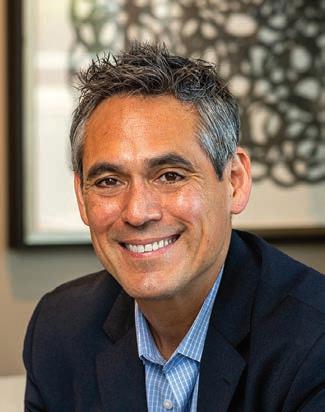

If someone were to ask you who you are, what makes up the fundamental “you-ness” of you, your instinct may be to turn to your memories.
I am the person who remembers ... growing up here, having this pet, going to this school, a first kiss, a first job, a first true love and a first true grief. But our memories are fragile, diaphanous, latticed with blank spaces like cosmic Swiss cheese. We don’t remember most of what happens to us day to day. But what we do remember, with iconic and epochal clarity, are the holiday traditions we loved as children.
Nothing in our memories defines us as vividly, as beautifully, as joyfully, as how we spent our holidays as children. This issue of 603 Diversity celebrates the traditions that our friends and neighbors from the Granite State have carried here, whether from around the world or down through the ages, or both; shimmering technicolor visions of distilled cultural memory; as beautiful and evocative as shining glass balls on a balsam fir.
My earliest memories of the holidays are in Vermont. Sugar on snow. Making popcorn balls in a steamy kitchen while snow swirled around the windows. The strange and lovely strains of the Bonanza Christmas album wafting the voices of Lorne Greene, Dan Blocker and Michael Landon through the house. (This weird and wonderful album was formative in some way I can hardly describe, but certainly has something to do with my ability to take kitsch absolutely seriously and sentimentally.)
There was the trip out back through the snow to cut a tree (my grandfather kept a Christmas tree farm and the pines behind the house were tagged year-round with leftover ribbons of various colors denoting size and price). There was Mass on Christmas Day, no presents until
afterward, though stockings were fair game once everyone was awake. When we were a little older, Mass became Midnight Mass on Christmas Eve, and my memories are from the balcony, half dozing as the incense smoke drifted toward the high vaulted ceiling of the nave, filled with dancing shadows in the flickering candlelight.
Like our dreams, our holiday memories will be most relevant to us, and like our dreams, they will always reveal something of ourselves to ourselves.
All these memories, of course, express themselves in our instinct to carry them forward, to share with our own children the things that are so permanently etched into our own hearts. Sometimes they love them as much as we do. Sometimes they roll their eyes. (Oh, dad and his stupid Bonanza Christmas album, puh-lease.)
But in this way, our holiday traditions are akin to our DNA. We are driven to pass them down through time, to make sure our children know them and that some piece of them outlives us.
That’s what makes them such enduring carriers of culture and heritage, and why this issue of 603 Diversity, collecting as it does, traditions from many places that are now a part of our own Granite State heritage, so powerful.
Wishing you all joyful, peaceful, and loving holidays. 603
PS. Was playing the Bonanza Christmas album, "Christmas on the Ponderosa," on Spotify as I wrote this, and may well have been as misty-eyed as Chevy Chase in "National Lampoon’s Christmas Vacation" when he’s stuck in the attic and finds the old movie reels of his childhood Christmases. Which, frankly, is why of all the "Vacation" movies the Christmas one holds up so well. We’re all a little bit Clark Griswold this time of year.






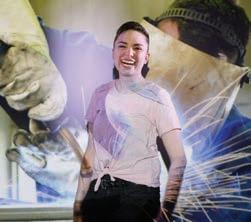



Contributing Photographers
Contributing Artist Richard Haynes
Editor/Publisher
Ernesto Burden x5117 ernestob@yankeepub.com
Managing Editor Mike Cote x5141 editors@603diversity.com
Managing Editor, Custom Publishing Sarah Pearson x5128 sarahekp@yankeepub.com
Creative Services Director Jodie Hall x5122 jodieh@yankeepub.com
Graphic Designer Christian Seyster x5126 christians@yankeepub.com
Senior Production Artist Nicole Huot x5116 nicoleh@yankeepub.com
Sales Executive John Ryan x5120 johnr@yankeepub.com
Operations Manager Ren Chase x5114 renc@yankeepub.com
Information Manager Gail Bleakley x113 gailb@yankeepub.com 250
Manchester, NH 03101 (603) 624-1442
Email: editors@603diversity.com
Advertising: sales@603diversity.com


Raised in a diverse community in Boston, Massachusetts, Suzanne Laurent worked as a registered nurse for the Boston Head Start Program. She moved to Toronto, Ontario, in 1982, and unable to work as a nurse, Laurent pursued a career in photojournalism. She has been a resident of New Hampshire since 1987. She has an extensive award-winning background in journalism. She is also a juried photography member of the New Hampshire Art Association and a published poet.
James McKim, who was involved in the original planning of 603 Diversity and has written essays for past issues, serves as managing partner of Organizational Ignition. He is driven by an intense need to help organizations achieve their peak performance through the alignment of people, business processes and technology. He is recognized as a thought leader in organizational performance, the uses of neuroscience and program management.


A regular 603 Diversity contributor is Rony Camille, a freelance journalist and a native of Canada. He became a U.S. citizen in 2019 after being a U.S. permanent resident for nearly 25 years. Camille is currently the media program director for the Town of Tyngsborough, Massachusetts.

Primary photographer for 603 Diversity is Robert Ortiz of Robert Ortiz Photography. Ortiz began his photographic career at 15, and has chronicled everything from local weddings and events to the lives of the native peoples of the Peruvian Amazon. He lives in Rochester with his wife and son and 15-year-old daughter, Isabella, who is currently in training as his photo assistant.

Sarah Pearson is managing editor of custom publications for Yankee Publishing, which produces 603 Diversity and many other titles. She is an award-winning editor and journalist who previously worked for a newspaper. She is a lifelong New Hampshire resident and mother of two.

Advocate, coordinator and educator Yasamin Safarzadeh, a native Angelino and current resident of Manchester, compiled our calendar and wrote the feature on “Echoes and Shifts.” Safarzadeh hopes to secure a future for a more diverse young adult population in New Hampshire to ensure a more prosperous and effective future for all. DM her at phat_ riot on Instagram.
Michael Sterling has been involved in photography for more than 40 years. After moving to the New Hampshire Seacoast in 2005, he became active in the local photographic community. He is a past president of the New Hampshire Center for Photography, a juried artist in the New Hampshire Art Association, and a member of the Kittery Art Association. He has been a contributing photographer for local print and online newspapers and magazines. Sterling was a photographer for local events such as PortsmouthNH400, TEDx Portsmouth, the New Hampshire Film Festival, and the Portsmouth Symphony Orchestra. He lives in Portsmouth.
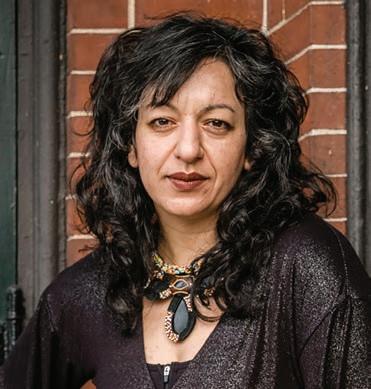
Dr. Wildolfo Arvelo is president of Thrive Collective, consulting on nonprofit leadership and management, property development, board development and fundraising. Prior to that, Arvelo served as executive director of Cross Roads House and director of the Division of Economic Development for New Hampshire. From 2007-2017, he served as president of Great Bay Community College in Portsmouth. Arvelo has a doctorate in educational leadership from the University of Massachusetts/Boston.
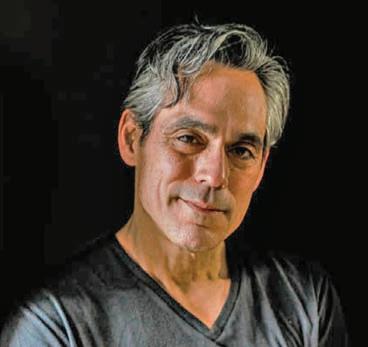
As publisher of New Hampshire Magazine and the NH Business Review, Ernesto oversees their publication and that of 603 Diversity, NH Bride and many more. He’s also a writer who’s published a couple of novels, a bunch of short stories and a livelihood of non-fiction pieces. Outside the office, you might spot him running around Manchester and at the 2025 Boston Marathon, or playing guitar and singing at one of southern New Hampshire’s bars and restaurants.
Caitlin Andrews has been a reporter and writer for nearly 10 years and has covered everything from politics to restaurant openings. She lives in Maine.

BY SARAH PEARSON

fter five years of holding events and programming at various partner locations, Black Lives Matter NH has a central hub of its own as of late summer. This space will house the offices of BLM NH’s full-time staff members, a community gathering space and a resource closet.
“We have been around for about five years,” said executive director Tanisha Johnson. “And we’ve been expanding a lot over the past two years.”
The community space will be used for BLM NH’s own programs, of which there are many, plus can also be reserved by partners for programs, workshops or co-working space. Right now, use is by appointment only, but staff and volunteers expect the hub to eventually have regular hours for drop-ins.
BLM NH’s programs are mostly free, except for its annual fundraising events. They have a BLM NH youth program that meets monthly and support groups for mothers, fathers, mental health, music and reflection, and monthly community conversa-
tions. In October, it held a banned books event with an essay and art contest, with a book swap and bookmark giveaway, in alignment with the national Banned Books Week. It also held a trunk-or-treat event in partnership with Vida Cantina.
While the programs are centered on Black lives, all people of color and white allies are welcome to participate.
The organization has made mutual aid part of its mission since its launch. This year, it received nearly 50 requests for aid, but it wasn’t able to fulfill all of them.
It hopes to provide $60,000 to community members in need by the end of the year, said Johnson. Mutual aid could include things like support for rent and utilities, summer camp fees and the cost of emergency repairs that are typically hard to get covered by traditional loans.
Through its resource closet, the hub also provides items such as school supplies, personal care items and toiletries, baby care supplies and reproductive care items as available. Before having this new space, resources and mutual aid operated
out of members’ homes or storage units. Johnson said that collections were difficult to coordinate without a dedicated space. Now, with a place to call home, BLM NH expects to be able to grow its community resources distribution.
“We’re truly invested in how we give back,” Johnson said.
Mutual aid and BLM NH’s free programs are made possible through monthly sustaining donors, one-off donations and the occasional grant, Johnson said. BLM NH is always seeking additional support.
“One thing we want to tell the community is we are here and we’re not going anywhere,” Johnson said. “We need community support to do that.”
The hub has been open since August, but a grand opening celebration won’t be held until November. Positive Street Art, a BLM NH partner, is working on a mural installation for the space. 603

For more information or to set up a time to visit the hub, email info@blmnh.org.



At NH Mutual Bancorp our values drive a culture of respect, inclusion, and belonging where we embrace the uniqueness that each individual brings forth to our organizations. Values are at the core of who we are; they drive innovation, foster collaboration and a respect for diverse thought and unique experiences. Ultimately, they ensure that individuals feel welcomed and empowered to succeed.
We are committed to dedicating our efforts, including leadership focus and financial investment, to promoting equal opportunity across our work environments and within the communities we serve. Doing so makes us a stronger, more successful, and sustainable organization over the long term.
www.nhmutual.com/careers/
BY CAITLIN ANDREWS / PHOTOS BY MICHAEL STERLING


When La Mulita Coffee first opened, Max Pruna spent a lot of time talking to customers.
Not many customers, he said, but a few very curious ones – those who wanted to know not just what made his Colombian coffee special, but who he was and where he was from, and why he came to New England.
New businesses often take time to get off the ground, but Pruna thinks his coffee shop faced a little extra headwind in Rye, where the coffee shop that is the face of his business is located.
"There aren't too many Latinos within this area, so you don't have a community already in place, so you have to make a great effort to explain where you're coming from and what you're trying to do," Pruna said.
"I think the product and the origin of the coffee was not something new to them – I think ‘who’ was new, me as a person, bringing that forward, and the name of our company, that really was new," he added.
Immigrants in New Hampshire make up a small but significant part of the economy: They comprise 12.5% of the manufacturing industry, 8.4% of the education industry and 7.8% of the health care and social assistance industry, according to data from the 2023 American Community Survey compiled by the American Immigration Council. Despite being 7.1% of the population, they are 8.3% of the workforce.
Their participation can often bring something new to the state, whether it is a
younger workforce to counteract the aging population or businesses unique to the area. A 2022 report from the Bipartisan Policy Center found that immigrants are likely more willing to start their own businesses because they are already primed to take risks by moving to the United States.
Changing policies at the federal level could alter the state’s small immigrant community by deterring people from coming to the United States or causing them to leave prematurely, said Steven Hubbard, a data scientist for the American Immigration Council.
“To stay ahead globally, we need to have workers from many different parts of the world come here. It makes us more competitive, especially in those STEM fields and those professional and scientific
areas,” he said. “I think some of that's going to be hurt when we're making it very limited on which workers come to the United States.”
Similar concerns were raised by the state last fall, after a New Hampshire Employment Security bureau report found foreign-born residents have a higher workforce participation than the U.S. average.
“Foreign-born workers who are not naturalized citizens are most at risk of changing U.S. immigration laws, and industries with a high concentration of noncitizen workers may struggle with labor shortages if widespread deportations, reduced visa quotas or other anti-immigration policies are enacted,” the report read. “Labor shortages would lead to increased competition for remaining workers in those sectors, driving up wages.”
With not enough young people entering the workforce to replace retiring workers, the state needs people from outside to survive, the bureau found.
“New Hampshire’s labor force will need to keep growing to support these obligations, and migration (both domestic and international) will be necessary to maintain labor force growth,” the report concluded.






For Jose Mojica, getting a foothold in the Manchester community for his Puerto Rican-styled bakery started with word-ofmouth advertising. He originally came to the U.S. as an airline worker working out of Boston and Manchester before he decided to start Dulces Bakery, which specialized in tres leches.
After a rough patch during the COVID-19 pandemic, Dulces closed, but Mojica has since revived it as Dulces Bakery La Casa de los Tres Leches. He currently works out of a commissary kitchen in Manchester, but Mojica said he hopes to reopen a storefront or a food truck in the near future.
Having a Puerto Rican-focused business meant having something new that appealed to everyone, Mojica said. He sees it as an ability to connect with people from all over, and to have a unique business unlikely to be replicated.
“We weren’t competing with anybody,” he said. “That was the plan, to have something that nobody had.”
Pruna, of La Mulita, came to New Hampshire in 1999 to study business. After
working in insurance and a real estate side hustle for years, he became inspired to try coffee roasting after hearing a talk from renowned coffee roaster George Howell.
Pruna thinks he had some advantages when he opened La Mulita six years ago because people recognize Colombian-sourced coffee from the grocery store. But the first three years were a challenge, as people took time to understand the name of the company and its unique approach to coffee, which is grounded in direct sourcing from farmers in the Colombia mountains.
Initially, Pruna was unsure if he should name his business after the mules that coffee farmers use to transport their beans. In the end, that connection to Colombia is what he thinks will sustain his business into the future.
“The more I questioned it or brought up the name to other people in Spanish, the more they told me it would be better to name it La Mulita, which would be authentic – not only because it’s an important animal used by the farmers, but because it’s a great symbol,” he said. 603
NH Songa


NH 8 A.M. - 4 P.M.
NH Songa, a one-day conference on immigrants in the New Hampshire workforce, will be held Nov. 19 from 8 a.m. to 4 p.m. at the Grappone Conference Center in Concord. Attendees will learn more about the immigrant community, talent empowerment, workplace inclusion, DEIJ benefits and challenges, and affirm the contribution of immigrants with data. Discussions will focus on immigrant inclusion, best practices to integrate immigrants into the workforce, and ways to maintain positive momentum. Learn more or register at nhsonga.com MARK YOUR
• Borrow Up To $5,000
• 8.99% APR for 12 Months*
• 9.99% APR for 24 Months*



*A full application for credit is required to be completed in addition to this loan request. APR = Annual Percentage Rate. Effective 10/1/2025. The rate may vary depending on each individuals’ credit history and underwriting factors. All Credit Union loan programs, rates, terms, and conditions are subject to change at any time without notice. Published rate includes a 0.25% discount given for direct payroll deposit, electronic payment method, and eStatements for the full term of the loan.
trianglecu.org • (603) 889-2470
Scan the QR code to apply or visit trianglecu.org/borrow/personal Federally Insured By

Everyone deserves to
find their
perfect place to call home, a space where they feel safe, seen, and celebrated.
“I believe real estate is about more than just transactions— it’s about partnering with clients through major life transitions.
Whether you’re purchasing your first home, moving your family, or embracing a new chapter, I recognize the deep, multigenerational significance of this process. My promise is to treat this work as sacred and personal, focusing relentlessly on minimizing your stress and clearing the path to your goals. Ready to start your journey? Let’s navigate it together.”
We understand that for our LGBTQ+ community, this search can sometimes come with unique considerations. That’s why we’ve built our business on a foundation of genuine care, unwavering support, and a deep commitment to our community. More than just a real estate team, we actively support local LGBTQ+ organizations, because we believe in investing in the wellbeing and vibrancy of our community. We see you, we value you, we’re one of you, and we’re here to help you navigate the real estate journey with confidence and peace of mind.



Michael Jewer Real Estate Advisor & Lead Agent michael.jewer@compass.com 978-983-1580





A new Pride event joined the Granite State itinerary this fall. The ACLU of New Hampshire hosted the first community Pride event for the Plymouth area on Oct. 4 at Riverside Park. Groups participating in the event included 603 Equality, Queerlective, Plymouth Rotary Club, Voices Against Violence, and Reproductive Equity Now.
The ACLU NH website notes that, in New Hampshire and across the country, LGBTQ+ people are being targeted by legislation to strip away their rights, safety and fundamental freedoms.
“That’s why it’s more important than ever for us to celebrate Pride,” it says. “We will protect our communities and speak truth to power. After all, Pride is, and always will be, a protest.”
On June 28, 1970, on the first anniversary of the Stonewall Uprising, the first Pride marches were held in New York, Los Angeles and Chicago. Thousands of LGBTQ+ people gathered to commemorate Stonewall and demonstrate for equal rights.
The Plymouth event concludes the 2025 Pride celebration calendar in the state, which is largely concentrated in June (Pride Month) and September. Events span from the North Country to Nashua, Keene to Portsmouth, in more than 10 cities and towns.














BY SARAH PEARSON

Sarah Pearson’s dad, Stephen, with her cousin Renee, 1991

s a child, my maternal side of the family lived in a triplex with my great-grandparents on the first floor, grandparents on the second, and the third floor at times was used by other relatives or guests of my grandparents. I’ve been fortunate to know five of my eight great-grandparents, many of whom were the first generation of their family to live their whole lives in the United States after their parents had relocated to New England mill towns from Canada. When the winter holiday season arrived, amid all the pageantry, tradition and activity, so too arrived a crush of relatives: greataunts and uncles, cousins of all degrees squished together.
There were so many of us in that tight apartment that, once all the adults were seated for Christmas dinner, the children (relegated to the “kids’ table” across the hall in my Pepere’s office) would have to crawl between legs and under the table if we wanted to reach the bathroom on the other side of the kitchen.
My memere and pepere, and their parents, were fluently bilingual in Quebecois French and English, and my mother and matante (aunt) passably so. As Santa’s
midnight hour neared, it always seemed like the French conversations overtook the English ones that we children could understand. As my cousin and I learned more French nouns, it became a challenge to try and riddle out what presents they might be trying to obfuscate from us.
Often, we would exchange gifts with the extended family on Christmas Eve. Dinner that evening would be simpler fare, like the traditional French-Canadian Tourtière or meat pie (heavily doused with ketchup by the kids). Christmas Day featured church, with a longer-than-usual Mass thanks to a reenactment of the Nativity and all the visiting relatives joining the Communion line. After was the main Christmas meal; a feast akin to Thanksgiving with a ham, mashed potatoes, rolls, veggies galore and oh so many pies.
Over the rest of this edition, 603 Diversity will share about a few other holidays celebrated in New Hampshire. While the traditions and festivities of these have their unique histories, you’ll see recurring themes of family, faith, heritage and connection with community. Whatever you plan to mark on your calendar this season, happy holidays! 603
3 pounds ground pork
¾ pound ground beef
1 me dium yellow onion, diced
4 p otatoes, peeled, cubed and parboiled
B ell’s stuffing (12-oz box) or similar seasoned stuffing mix
24 ounces of water
4 r ounds of pie crust, either pre-made or following a recipe of your choosing
In a saucepan, brown the meat with onions. Add seasonings and water, and let simmer for three to five hours.
Remove from heat and stir in stuffing and potatoes.
Prepare two 9-inch pie pans with bottom crust doughs. Divide the meat filling between them.
Top with an upper crust dough. Crimp the edges of the pie crust and poke some holes in the top crust to allow steam to vent.
Bake at 375 degrees for 45 minutes.
Note: While pork is popular for tourtiere, there’s no one way to make it. My mother has made it with venison or moose; sometimes others use veal, rabbit, bear or whatever is available. If you’re using lean meat, you may still wish to include some pork, as the fat content helps keep the pie from becoming too dry while baking.
BY SUZANNE LAURENT

PHOTOS BY ROBERT ORTIZ
While losing a loved one is a solemn occasion of mourning, in Mexican culture, those who have passed on are remembered in a sentimental, even joyful, way during Día de los Muertos, the Day of the Dead.
“It’s a favorite tradition of my culture,” said Maria Garnica, who owns the El Viajero Restaurante Tradicional Mexicano
in Hooksett with her husband, Miguel. “It reunites the living and the dead.”
The holiday is a blend of Indigenous and Spanish Catholic traditions that has become a national symbol in Mexico and a popular, evolving celebration in the United States. It began as an ancient Aztec custom of celebrating ancestors with All Souls’ Day, a holiday that Spanish invaders brought to Mexico starting in the early 1500s.
It is celebrated on Nov. 1 and 2, the dates of the Catholic All Saints Day and All Souls Day. It follows Halloween on Oct. 31, also called All Hallows Eve, which originated as a vigil before Día de los Muertos.
The holiday is like a family reunion — except dead ancestors are the guests of honor. Día de los Muertos is a joyful time that helps people remember the deceased and celebrate their memory.
“November 1 is for the children who have died,” Garnica said. “Adults are celebrated on the 2nd.”
Born in Jalisco, Mexico, Maria Garnica grew up in Mexico City and came to the United States in 2016 for college in Tennessee. There, she met her husband, who was also from Jalisco.
“We moved around and tried out different places,” Garnica said. “Miguel has family here in the Tilton area, and we ended up in Hooksett.”
They grew fond of their new town and worked at different restaurants. Miguel, especially, worked in all different positions at the restaurants.
“Families believe the souls of the dead come back to visit. We believe that death is a natural part of the life cycle.”
— Maria Garnica
In 2024, they opened their own establishment, El Viajero Restaurante Tradicional Mexicano, in Hooksett. El Viajero means “The Traveler,” who the couple says stands for what they are in essence, as a family — El Viajero with a dream.
While Miguel does the day-to-day cooking and running of the restaurant, Maria takes care of the administrative tasks. The couple have four children, ages

2 months (at the time of a September interview) to 7 years old.
“We haven’t lost anyone but my grandfather on my mom’s side. He was almost 100 years old with a strong personality,” Garnica said. “We mourn that we wish he was happier in life and had a happier childhood. It’s a bittersweet feeling.”
The most prominent day is Nov. 2 when they gather at cemeteries, she said.
“We bring colorful marigold flowers (cempasúchil), as well as foods that loved ones liked. There is a lot of singing welcoming them back in the spirit of reunion,” she said. “Families believe the souls of dead come back to visit. We believe that death is a natural part of the life cycle.”
Garnica said it is customary to build an ofrenda (altar) in their home.
“It has a lot of symbolism. It’s like a seven-level pyramid, and everything has a purpose. There are photographs of the deceased, candles, marigold flowers — bright in color. The scent of the marigold and incense calls them back,” she said.
“We bring water to quench the thirst
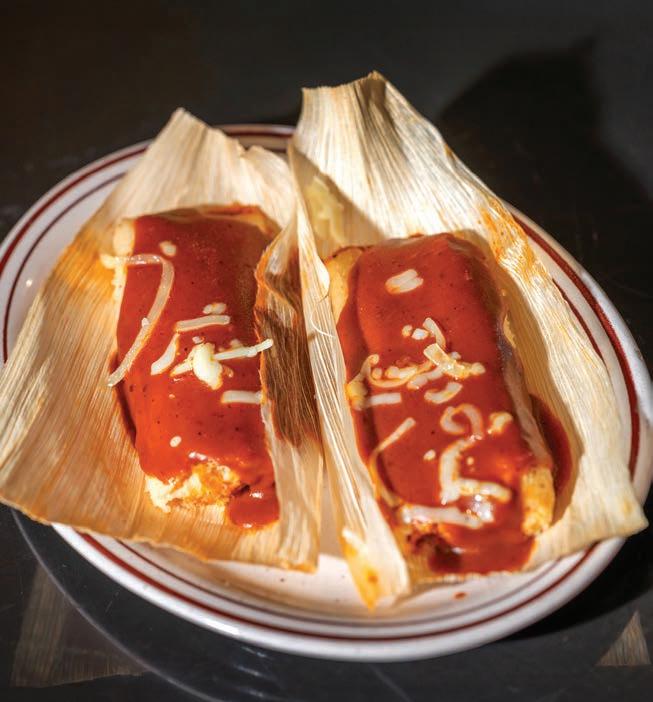


It takes more than love to care for a loved one. Help is Here. Get the caregiving support you need when you need it.
No one ever hopes to become a family caregiver. But it’s a role you and 168,000 others in New Hampshire play every day. No matter how much you love the person you’re caring for, being a caregiver can be a lot to manage.
AARP Family Caregiving is here to help. We can make it easier for you to get answers, help you connect with and learn from other family caregivers and guide you to useful resources online and close to home.
To learn more, visit aarp.org/caregiving

/aarpNH @aarpNH

of the souls, and some bread. We also add personal items they enjoyed in life, like books, toys or instruments. We add colorful delicate paper to represent life in the wind. We add salt for purification of the soul and crosses, rosaries and images of the saints.”
On Nov. 1, Dia de los Angelitos (Day of the Little Angels) starts the holiday at midnight, when the spirits of all deceased children are believed to be reunited with their families for 24 hours.
Families will construct an ofrenda with colorful designs. They will add the departed child’s favorite snacks, candies, toys and photographs to encourage a visit from their departed children. The names
of the departed children will often be written on a sugar skull or one made of chocolate.
During Día de los Muertos, it is common to see life-size papier-mâché skeletons and miniature plastic or clay skeletons. Its symbolism for Mexicans is to honor their ancestors on the Day of the Dead, but also reminding themselves that death is just a part of life.
Día de los Muertos is a rare holiday celebrating death and life. It is unlike any holiday where mourning is exchanged for celebration.
To learn more about El Viajero Restaurante Tradicional Mexicano, visit elviajerohooksett.com. 603
Shared by David Vargas, owner of Vida Cantina, Portsmouth
4 cups all-purpose flour
2 tsp. baking powder
2 tbsp. sugar
1 tsp. salt
2 eggs
2 tb sp. butter, melted and cooled
1.5 cups warm water
2 tsp. vanilla paste
In a stand mixer or large bowl, add flour, baking powder, sugar and salt.
In a medium bowl, whisk together egg, melted butter and vanilla. Slowly add the wet ingredients into the dry ingredients until it’s soft and forms a smooth dough. The dough should not be sticky. Cover the dough with a kitchen towel and let it rest for 30 minutes in the fridge.
Weigh out 1-ounce balls and roll out perfect circles. Store them like hand-pressed tortillas on half-sheet trays with plenty of flour.
Heat oil in a skillet to 350°F. Carefully place the dough into the hot oil and fry on both sides until golden brown. Remove from the skillet and place on a paper towel to drain excess oil. While still warm, coat with cinnamon sugar and finish with a drizzle of agave.

BY RONY CAMILLE COURTESY PHOTOS

While many New Hampshire families unwrap gifts by the tree on Christmas morning, parishioners at The Over Comers Church of God in Concord gather for hours of worship, song and dance.
For them, Christmas is not just a holiday; it is a bridge between home and homeland, a chance to celebrate the birth of Christ and keep alive the traditions they once knew in East Africa’s Great Lakes region.
Pastor Clement Kigugu remembers when the church first took shape. Refugees arriving from the Democratic Republic of Congo, Burundi and Rwanda more than a decade ago longed
for a place to worship in their own languages and with the same joyful energy they knew back home.
What might be a one-hour service here in the States often stretched to three, alive with drumming, singing and testimony.
For Kigugu, Christmas has always been first and foremost about worship. Gifts and food follow, but the heart of the holiday is in honoring the birth of Jesus.
“It’s Jesus’ Day,” he said.
Adults in the community still embrace that tradition, while children lean toward American customs of presents and candy, he said. What ties both generations together is the food: Congolese fufu made from cassava flour, plantains, beans and meat, according to Kigugu.
In East Africa, families might slaughter a goat or cow for the holiday feast; in New Hampshire, the dishes keep that spirit alive. “When we eat fufu and cassava leaves, we know we are home,” he reflected.
If Christmas at Over Comers ties Concord’s African diaspora to its faith roots, Kwanzaa has become the bridge for Black communities in Nashua and Manchester to honor culture and history.
the
“It brings together those who came from the islands, from Africa, and those born here. It brings us into one great network of people.”
— Kendra Soucie-Smith
Created in 1966 by Maulana Karenga, Kwanzaa celebrates African heritage and values through seven guiding principles, from Umoja (unity) to Imani (faith). In New Hampshire, groups like the Greater Nashua Branch of the NAACP, the NH Black Women’s Health Project, and Victory Women of Vision have kept those principles visible through annual celebrations between the communities of Nashua and Manchester.
For longtime organizer Brenda Lett, the holiday is about cultural pride and continuity. She describes it as unapologet-

ically African American. Not religious, not heroic, but rooted in heritage. In earlier years, celebrations often took the form of potlucks, where each dish carried a story. She remembers once bringing jerk salmon to an NAACP gathering, which opened conversations among people tasting it for the first time.
Even now, with health rules requiring catered food, the goal remains the same: breaking bread together to strengthen cultural bonds.
That spirit was on full display at Soel Sistas, a Black woman-owned restaurant in downtown Nashua that has hosted the local Kwanzaa gathering for the past two years.
Owner Kendra Soucie-Smith turned her dining room into a community hub, serving soul food staples like catfish, collard greens, mac and cheese, pecan pie, peach cobbler, and rice and peas. She admitted it was moving to see the space filled in this way, recalling how, during the first NAACP celebration, she realized, “It’s nice to make this place the hub.”
Her father, Charles Richardson, a Bellamy, Alabama, native who has lived in New Hampshire for half a century, captured

the significance of the moment with a grin, quietly asking his daughter, “Kendra, where did you find all these Black people?”
Greater Nashua Branch of the NAACP president Linda Gaitwright said that the event drew a strong turnout and reminded her of Kwanzaa’s larger purpose: connecting people across different Black identities. “It brings together those who came from the islands, from Africa, and those born here,” she said. “It brings us into one great network of people.”
Across New Hampshire, these holidays are more than dates on the calendar. They are markers of identity for communities building new lives while holding close to traditions from home.
For Kigugu, Christmas remains “Jesus’ day” above all else.
For Lett, Soucie-Smith and Gaitwright, Kwanzaa is about celebrating ancestors and instilling values of unity and self-determination.
Together, Christmas and Kwanzaa show how culture and faith travel, adapt and take root in new soil. In the cold of a New Hampshire December, they bring warmth, memory and a sense of belonging 603


Cassava flour or corn flour (you can also blend both) Water
In a medium pot, bring 3 cups of water to a boil.
Shared by Clement Kigugu
In a separate bowl, mix 1 cup of room-temperature water with the flour to form a smooth paste (this prevents lumps).
Gradually pour the flour paste into the boiling water, stirring constantly with a wooden spoon. Continue stirring and pressing the mixture against the sides of the pot until it thickens and becomes smooth, stretchy and soft, like dough.
Reduce the heat and keep stirring for 5–7 minutes, until fully cooked.
Shape into round balls using a spoon or your hands
Fufu is best enjoyed with your favorite soup or sauce, such as peanut stew, okra soup, fish, beans or vegetable stew. Traditionally, you pinch off a small portion with your fingers, shape it, and use it to scoop up the sauce.
Note: In many African cultures, Fufu is more than food — it represents community, family and togetherness. Meals are often shared from a common bowl, bringing people closer around the table.
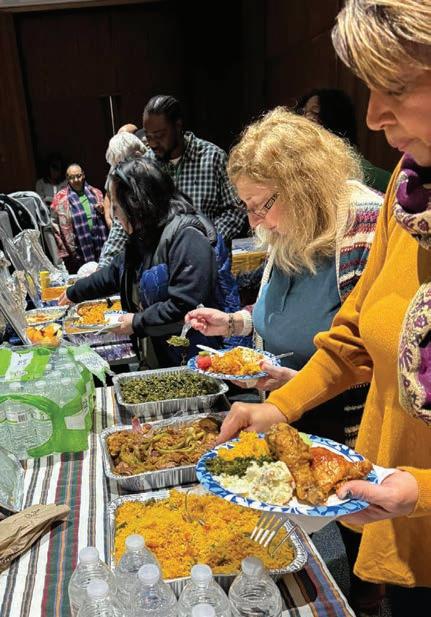

BY SUZANNE LAURENT
PHOTOS BY STEVE KENSON


candle is lit on the eve of the Winter Solstice and is kept glowing until sunrise, celebrating the return of the sun after the darkest night of the year. Yule also holds spiritual and magical significance. It is seen as a time when the veil between worlds is thin, making it easier to connect with spiritual energies, ancestors and deities.
This celestial event has been celebrated for centuries by various cultures, with Norse and Germanic roots. For pagans and Wiccans, Yule holds immense significance as a time of transition, rebirth and renewal.
This year, Winter Solstice and the beginning of the 13 days of Yule fall on Dec. 21 in the Northern Hemisphere.
But for members of the Temple of Witchcraft in Salem, NH, they will light a candle on Dec. 19 and celebrate the holiday on Dec. 20 at the Masonic Hall, also in Salem.
During Yule, some Temple members will join in an online meditation the night before, the eve of Winter Solstice.
“Our public, communal Yule celebration happens on or near the Winter Solstice, on the closest Saturday, since we need to rent the hall and have a time when the community can gather,” said Steve Kenson, Gemini lead minister of the Temple. “It is just one evening ritual, usually followed by a communal potluck.”
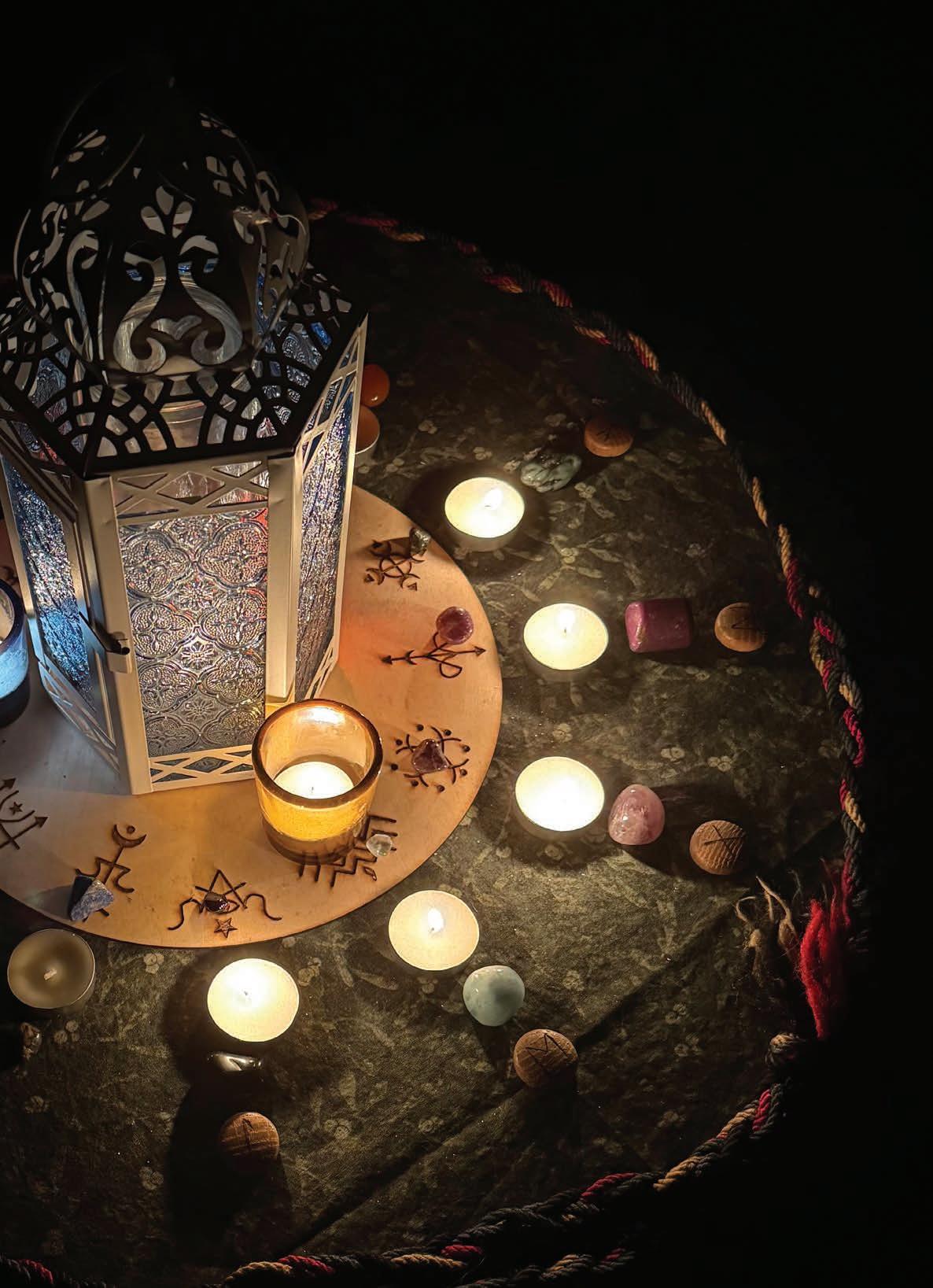

During the following days of Yule observation, members will celebrate at private or family events for those who choose to observe them. Pagan traditions for Yule center on celebrating the return of light, making plans for the coming year, and honoring nature and ancestors. In addition to candle-lighting, there may be divination practices, drumming or chanting circles, and group ceremonies to honor deities associated with the season.
“In the Temple of Witchcraft tradition, Witches celebrate ‘Mother’s Night’ on the eve of the Winter Solstice, reciting their matriarchal lineage as far back as they remember, and all the spiritual mothers in their life, as the Great Mother is about to give birth to the Sun Child,” said Christopher Penczak, the temple’s Sagittarius lead minister.
Then, for the next 12 days,
they celebrate the 12 spirits of the zodiac, starting with Capricorn, as the sun enters the sign of Capricorn during the Winter Solstice, and ending on Sagittarius.
On these days, they do divinations with tarot cards, runes and other symbols, to give themselves a reading for each month of the coming year.
Founded by Kenson, Penczak and Adam Sartwell (Virgo lead minister), the Temple of Witchcraft started in 1998 as a system of magickal training and personal development, and eventually developed into a formal tradition of Witchcraft.
The temple has a range of 800 to 900 participants internationally.
Shared by Christopher Penczak
½ ounce base oil such as olive oil or grape seed oil
12 drops of frankincense essential oil
5 drops of myrrh essential oil
4 drops of orange essential oil
3 drops of fir needle essential oil
2 drops of cedarwood essential oil
2 drops of wintergreen essential oil
1 drop of cinnamon leaf essential oil
1 drop of clove bud essential oil
Approximately 300 to 400 of these may be education-based participants who are taking classes offered by the temple.
Now, as an outgrowth of the work of students, initiates and graduates of the programs, the Temple of Witchcraft has evolved into an organization based on traditions of modern magick, Witchcraft and neopaganism.
Penczak is its primary teacher and public ritualist as well as an author of numerous books. He explained that the zodiac sign of Sagittarius in his title aligns with his adventurous and spiritual strengths.
Born in Lawrence, Mass., in 1973, Penczak was raised in an Italian/Polish family while living in Salem, NH. After 12 years of Catholic school and becoming an avowed agnostic struggling with the intersection of his spirituality and queer sexuality, he initially pursued an interest in chemistry, stemming from a childhood fascination with alchemy and herbalism.
He attended the University of Massachusetts as a vocal major, earning a Bachelor of Music Performance/Music Business in 1995 and setting his sights on becoming a full-time performer.
While in college, a longtime friend and teacher introduced Penczak to the principles of Witchcraft, meditation, tarot and spell work. At first, he was skeptical, but his experience with a healing spell at a full moon ritual was enough to convince him that there was truth to these ideas, and he sought to understand more. He took classes with the Official Witch of Salem, Mass., Laurie Cabot, in her Cabot Tradition with an emphasis on Witchcraft as a science.
Add drops of essential oils to the base oil, gently swirling each in with a clockwise swirling motion. Do a skin patch test in a small section of your skin to make sure the oils do not react to your skin. Anoint your wrists, brow and back of your head, where the spine and skull meet, to bless and protect yourself on the dark Winter Solstice night, and to evoke the blessings of the Sun. The oils used in this recipe can often be found at herbal shops, health food stores and at various herbal retailers online.
After graduation, Penczak began work at the A&R department of Fort Apache,
a recording studio and record label in Cambridge, Mass.
Yet, he soon found himself leading meditations and ritual groups for friends seeking to know more about the craft. During his time in the Boston area, Christopher experimented with the ideas he later wrote about in his first published book “City Magick: Urban Rituals, Spells and Shamanism.”
Penczak explained that in addition to the candle burning all night during Winter Solstice Eve, there is a special altar set up that includes the four elements of earth, air, fire and water. Earth is represented by a stone; air by a sword; fire by a wand; and water by a cup. The altar can also hold candles, oil for consecration, incense, bells, frankincense and myrrh, and pine needles.
Key practices for the Winter Solstice include decorating with evergreen boughs
and natural items, burning a Yule log for cleansing and new beginnings, holding feasts, decorating a Yule tree, and engaging in rituals of reflection and selfcare, like staying up all night to welcome the sunrise.
“While it is customary to light an actual log, since we’re in the Masonic Hall, we light candles,” Penczak said.
Yule is also a time for gathering with loved ones and sharing a festive meal. Traditional foods include roasted meats, root vegetables, wassail (mulled wine or spiced cider), Yule log cakes, gingerbread and other seasonal treats. The feast is often accompanied by toasts, blessings and expressions of gratitude for the abundance of the season.
For more information about the Temple of Witchcraft in Salem, visit templeofwitchcraft.org 603







































































































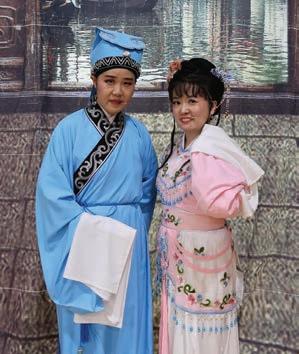






























































































































BY YASAMIN SAFARZADEH PHOTOS COURTESY OF ALI SEKOU
In Islam, when people gather together in numbers of four or more, it is customary to hold physical space with each other. The resilient Muslim community of Concord, comprising new Americans and natural-born citizens, had held spaces in liminal sites until 2017 when, with donations, the Islamic Society of Greater Concord gathered from the Muslim community members’ own pockets, they were able to secure a permanent site.
They purchased a hall from the former First Congregational Church and renovated it into a space for their services. This was a great joy for all who engage with the community.
When Ali Sekou moved to the region in 2012 from Niger, the founders of the society were already present and active, using rented space for services. Holidays like Eid remind Muslims of their core values.
“This special day brings peace, unity and countless blessings to all,” Sekou shared on Eid Al-Fitr, the end of Ramadan. “As we celebrate, let’s remember the values of gratitude, generosity and compassion that define this holiday.”
Sekou knows that the building that houses the vibrant activities of the Islamic Society is not the heart of the community. The heart of the community is its people: dedicated kinfolk who fund their own activities and needs and have never accessed any grants or outside funding. However, a space to call home helped extend their abilities to answer calls for aid.
The Islamic Society of Greater Concord, a member of the Greater Concord Interfaith Council, meets varying, vast needs: meal-prepping and serving, mutual aid, clothing drives, school supplies, education resources, prayer, speaking engagements, child care, even hosting traveling Muslims who pass through the region.
When the Afghani refugees were rehoused and needed to access halal food or clothes for the winter, the society answered their call. When individuals needed transportation, community members helped.
Even when there was local or global turmoil and hardship, the Islamic Society came together to pull funds and resources to send to those who were at risk or vulnerable. The society even comes together to provide for funeral costs for families who cannot afford to shepherd their loved ones into the next life. It also provides religious education classes to children.
The space is not one that takes and needs, but one that yields life and joy to those who use it.
After earning degrees from NHTI, Plymouth State University, and a master’s degree at the UNH Carsey School, Sekou was elected and served as president of the society


from 2020 to November 2024. During his tenure, he guided the center for renovation projects, occupancy permits and meeting its parking needs.
In 2023, Sekou was elected as Concord’s first African immigrant and Muslim city councilor. In 2024, he also ended his two terms as president of the Islamic Society of Greater Concord. He was succeeded by Shafiq Chaudhry.
“We are all fervent leaders of the Society,” Sekou says. Sekou says he prays five times a day: Fajr, Dhuhr, Asr, Maghrib and Isha. Other traditions of Muslims pray three times daily.
Muslims celebrate two major holidays (Eids) as a community, each with a unique soul and meaning: Eid al-Fitr, which happens at the end of Ramadan, and Eid al-Adha. Both Eids change dates yearly because it follows the Islamic calendar year.
Eid al-Fitr is a moment of celebration, because people fasted every day from sunrise to sunset. Fasting the month of Ramadan is to be grateful for all the bounty enjoyed during the other 11 months in the year. It also celebrates when the Quran was revealed to Muhammad from the Angel Jibril.
“During this feast, it is important to recall the reflections encompassing ideas of gratitude an individual can perceive in recounting the generosities experienced through their lives,” Sekou says. “In
Above: The Islamic Society invites the community in to break the fast with them during Ramadan. Among the guests of one such evening were WMUR Political Director Adam Sexton, Concord Mayor Byron Champlin, and Northeast Delta Dental CEO Tom Raffio. Below: Sekou with members of his congregation on Eid.

this time of charity, each act of giving is received and multiplied by the cosmos.”
The society hosts Concord and New Hampshire elected officials, industry professionals and community leaders for a dinner during Ramadan to share its traditions and build relationships.
Eid al-Adha encompasses the story of Ibrahim and the generosity of Allah, who forewent a direct sacrifice and allowed the father to submit a lamb in the stead of his son, Ismail. For the Islamic Society of Greater Concord, this sacrifice is personal to each member.
Sekou says that he and his family (wife Fatimat “Fanta” Sekou and two young children) secure a lamb for themselves and use a portion, then divide the rest among the community.
Additionally, the society sends funds to other regions, because the living standards of Muslims in Concord is higher than in other areas. The community acknowledges this fact and endeavors to remedy some of the burdens other Muslims may feel by forwarding fiduciary resources.
“You must be disciplined to be Muslim,” Sekou says. “You have to pray five times a day wherever you are. Prayer is not only an individual standing before God, but this individual must be clean in mind and body. Therefore, we must take care of our people, we must provide them with clean clothing, running water, a space to cleanse their thoughts and quiet their mind and a quiet place to pray.”
Those efforts go back to the core of what the society feels it’s called to do in the community.
“The work of generosity and charity must be one without greed or ego,” Sekou says. “Your own left hand should not know the work of the right hand! You cannot look for a reward. If I buy rice and place this resource in the mosque, I can never ask where it goes, but I am assured that it will be received by those who need this rice.” 603
News from New Hampshire and

BY SARAH PEARSON PHOTOS BY PHOTOS COURTESY OF TEMPLE BETH JACOB




































The Jewish holiday of Yom Kippur is the holiest day in the faith’s calendar, but it’s not a celebration like so many other holidays. It involves a complete fast: no food, no drinks and many people refrain from wearing cosmetics or leather.
Translated as “The Day of Atonement,” Yom Kippur is a somber day of reflecting on your regrets from the past year, says Robin Nafshi, rabbi of Temple Beth Jacob in Concord.
“When I was very young, I used to say to people, ‘Oh, we go to synagogue and weep for our sins,’” she said. “I would have been like 9 years old. What did I know what a sin was?”






As a teenager, she began to have a deeper understanding of the tradition.
“I found it very powerful, this idea that, if our repentance is sincere, God will always accept it,” she says. “At the same time, we have to do the hard work of apologizing to those we’ve hurt.”
The Jewish liturgical new year begins with Rosh Hashanah, followed by 10 days of repentance that culminate in Yom Kippur. Five days after that period of reflection is Sukkot, a celebration of the harvest.
“There’s a whole concept during the period of Rosh Hashanah and Yom Kippur called teshuva,” Nafshi says. “Teshuva means anything from ‘repentance’ to ‘changing.’ It’s this taking stock of myself. I like to word it as becoming the person, or moving closer to becoming the person I know I am capable of being.”
While Yom Kippur requires much introspection, it’s done much in the company of the community. Like many congregations that saw lower attendance post-pandemic isolation, this year Nafshi says numbers were back to 2019 levels.


At Rosh Hashanah, attendants had to hurriedly take chairs out of storage for those who gathered. By Yom Kippur, the temple was better prepared for the crowds to gather more comfortably.
The service for Yom Kippur begins at sundown the day before. Nafshi says that in Concord, the program ran from 7:30 to 10 p.m. on Oct. 1.
“That’s the beginning of the service, and we can consider it to be one continuous service through the whole day,” she says. “We invite the congregation to leave in silence or just humming one particular melody that is very familiar throughout the holidays, and then we come back the next morning.”
On Oct. 2, services began at 9:30 a.m., with a break mid-afternoon, followed by three more shorter sessions. The service includes a couple of sermons (presented in English), spoken prayers (in a mix of English and Hebrew) and sung prayers (in Hebrew).
“There are many prayers that are set to music, that the melodies are incredibly evocative, and people may come to services mostly just to hear melodies that, for them, go back to their childhood,” she says. The songs feel much like the melodies that have been sung for hundreds of years, even if they’re newer.
There are periods where people can reflect in front of the open Ark, where Torah scrolls are stored. One of the afternoon sessions is specific to remembering those who have died, particularly in the last year. The closing session is called “Ne’ila.”
“It’s a metaphor about the gates of repentance,” Nafshi says. “The gates have been open for all the time, from Rosh Hashanah through Yom Kippur, and now the gates are beginning to close. It feels almost like there’s an urgency to make sure we get in all of our prayers of repentance.”
The service concludes with a long blast from the shofar, a ram’s horn.
“It’s a very raw sound,” she says. You’re making a sound that feels like it’s a cry. We say that the shofar is both that cry, but also the sound is something to awaken you.”
The blast from the shofar helps transition from this period of spiritual and emotional reflection to Sukkot, which is more grounded and earthy. Once the period of intense reflection is over on Yom Kippur, you don’t dwell in it. You move quickly to the next holiday. Nafshi says she loves that balance and forward-looking quality of Judaism.
“Our next holiday is in five days, and that’s the holiday of Sukkot, where we build a hut in our backyard,” she says. “Tradition teaches that you actually go outside that night and put the first two pieces of your sukkah, which is what the hut is called; you put them together so that you begin to already make the transition and get out of the place and mood of Yom Kippur, because our tradition is that you don’t stay there for very long.”
Families build the sukkah to connect with ancestors who lived in tents in the desert. They share meals out there and invite others to partake.
Tomorrow, I will register to vote in Manchester. I have planted a small perennial garden. I am giving myself permission to let it begin with me.603

BY JAMES MCKIM
Let’s start with a definition — because here in New Hampshire, we like things to be clear and orderly (not to mention I was a philosophy major in college, but very few born-and-bred Yankees are signing up to muck stalls at 4 a.m. in February).
New Hampshire’s population is changing faster than a snowstorm turns to spring mud. So, celebrating the state’s patchwork quilt of holiday traditions has never been more important, or entertaining. With a growing crowd of folks from near and far, our cultural and faith-based customs offer more than just a buffet of delicious food and catchy music. Rooted in religious, ethnic and social customs, they offer valuable insights for making the state more inclusive and a place where everyone can thrive, not just survive.
Move over maple syrup (but don’t leave). New Hampshire’s festivals are bringing flavor from every corner of the globe. The state’s newcomers bring traditions from Asia, Africa, Latin America and Europe, making our celebrations almost as diverse as the weather forecasts. This is adding a tagline to our motto of “Live Free or Die” — “Dance Freely and Try the Samosas!”
Between the Manchester We Are One Festival, Keene’s International shindig, and Concord’s Multicultural jamboree, there’s something for everyone: music, food, faith and probably at least one group dance you’ll pretend to understand. See the NH International Festival Navigator for more details on these events. (nhcommunitynavigator.org). Beyond entertainment, these gatherings serve as public affirma-
tions of inclusion supporting economic prosperity and nurturing a shared identity.
Holidays here come wrapped in wisdom, gratitude and hope, not to mention jazz hands and festive hats. Juneteenth marks resilience with tunes and tasty treats, while Indigenous Peoples’ Day helps us evolve “colonial” tales into genuine tributes and cultural awareness. Because nothing says progress like acknowledging you weren’t actually the first here.
Christmas gets a New Hampshire twist thanks to Native heritage and a sprinkling of colonial nostalgia. Meanwhile, Diwali, Hanukkah, Eid and Lunar New Year reveal ways to connect over shared hopes for renewal and peace while helping everyone light up the long winters and share peace — no batteries required.
Let’s face it: exposure to diverse holiday traditions encourages empathy and breaks down the stereotypes and barriers that have led to the divisions we see in our society today. Schools, offices and town halls are now swapping plain tinsel for multicultural decor and playlists — because “Jingle Bells” mixes surprisingly well with Bollywood beats and Caribbean steel drums. (Take a listen to the Caribbean Island Steel Drum Troupe’s “Island Christmas: Steel Drum Christmas Songs.”)
When schools, workplaces and public spaces acknowledge a variety of observances — by holding not only Christian/English events but also multicultural events, incorporating diverse music and art, and providing respectful accommodations during major holidays — they send a powerful
When schools, workplaces and public spaces acknowledge a variety of observances, they send a powerful message: All community members matter.
message: All community members matter.
Educators and employers can lead by example, inviting sharing and storytelling about family traditions, adjusting schedules, when possible, for religious observances, and decorating spaces with neutral seasonal imagery to avoid exclusion. Community calendars that highlight major holidays from different traditions help prevent unintentional oversight and promote understanding.
Learning from different traditions is less
about “checking the diversity box” and more about transforming isolation into inspiration. Participants in multicultural festivals report feeling more connected and less isolated. Children exposed to a range of stories, music and customs develop stronger cognitive, emotional and social skills, learning that difference is not a barrier but a source of creative strength. Jaime Feinberg writes in “Americans for the Arts” that NH towns that embrace multicultural events become destinations, stimulating local economies and building social resilience (blog.americansforthearts.org). Research shows that kids exposed to a grab-bag of customs and stories end up smarter and kinder; plus, they get really good at potluck dinners. By elevating diverse faith and cultural perspectives, New Hampshire becomes a place where hospitality is a lived value. Instead of simply tolerating differences, the state can create conditions for newcomers, longstanding residents and historically marginalized groups to contribute their best — cultivating innovation, trust and the confidence that everyone’s story belongs in the New Hampshire narrative. 603
If you want to feel at home and help neighbors flourish — whether you’re a lifelong Granite Stater or just moved here to escape Massachusetts traffic — try these out:
● Learn about and crash each other’s parties — er, traditions.
● Help put on public events where “potluck” means “global food coma.”
● Lobby for holidays off, whether you’re fasting, feasting or napping.
● Teach kids to appreciate differences — as long as they still take out the trash. Do this, and New Hampshire will be so vibrant, it might give the fall foliage a run for its money. And maybe, just maybe, everyone will feel at home, even if they still can’t spell Winnipesaukee.





BY WIL ARVELO
As a Puerto Rican American and first-generation immigrant to the mainland, the celebration of the Christmas holidays can be answered with two words: cultural amalgamation. While we are proud Americans, we are also deeply Puerto Rican and tied to the broader Latino and Spanish cultures with their diverse traditions. The fact that all Puerto Ricans have American citizenship and come and go freely between the island and the mainland allows us to traverse very different cultures with Christian traditions that bind us and allow us to find common ground with mainland Americans who are culturally different from us.
First and foremost, we are a Latino people with deep respect for Latin American and Spanish traditions. Spain, Cuba, Africa, Venezuela, Mexico and other Latin nations have influenced our music, our food, our religious devotion and our ways of expression. We also can’t forget the many African cultures and native Tainos who have contributed immensely to who we are as a people and our cultural traditions. We are also happy people with lively expressions and love for life and family. That means we love to party, and we love to eat.
Being cross-cultural means that we begin our entry into the holiday season not on Christmas Eve but on Thanksgiving. Think of it as an excuse to celebrate and party from the last week in November to the end of the first week in January, when we celebrate Three Kings Day. That’s six weeks of ongoing celebrations, family gatherings, music, dancing and food. Many of us begin with Thanksgiving, because we are familiar with this holiday. We may not know the history or its significance, but we can appreciate the idea of families coming together, being with each other and giving thanks. It is something that resonates with our core as Latinos. But the real highlight of our celebrations happen as we prepare for Christmas Eve and Christmas Day. Those are followed by saying goodbye to the old year and welcoming the New Year. Finally, on Jan. 6, we culminate the celebrations with the coming of
the Wise Men to meet baby Jesus, where they present him with gifts.
There is one tradition that is very Puerto Rican and very special. It is about celebrating who we are as a people, our bonds, our culture and our communities. That is the Paranda. It is so special that I think everyone needs to adopt/adapt this tradition. Believe me, all our communities would be better for it. Basically, we invite friends, family, neighbors and strangers into our homes to
We are a Latino people with deep respect for Latin American and Spanish traditions. Spain, Cuba, Africa, Venezuela, Mexico and other Latin nations have influenced our music, our food, our religious devotion and our ways of expression.
listen to music, usually playing traditional Puerto Rican music on a Spanish (acoustic) guitar, cuatro (10-string guitar), guiro (gourd), pandereta (tambourine), and percussion instruments such as tamboriles (small drums), conga drums and palitos (wooden sticks). These celebrations can go on all night and go from house-to-house or town-to-town where there may be a long trail of cars following each other through mountain towns to the next destination. Because parandas can go on for one night or several nights, the host is obliged to ensure that the visitors are welcomed and fed.
The list of foods is long and diverse, but here are a few delicacies that we celebrate with. From
a young age, I remember staying up late helping my mother and grandmother prepare pasteles. These would be shared with the whole extended family and given to friends and acquaintances. These are made in a variety of ways depending on the region, but usually include a masa (dough) of green bananas, plantain, yuca, yautia and pumpkin, which is then filled with stewed pork and wrapped in banana leaves and parchment paper and boiled. We also eat rice and gandules (pigeon peas), pernil (roast pork), lechon asado (suckling pig slow roasted on a spit) and gallina vieja, a soup of older chickens which provides a more flavorful broth, and morcilla (blood sausage and rice). For dessert, we will enjoy Arroz con dulce (coconut rice pudding) and tembleque (coconut custard). Of course, we can’t forget the coquito, Puerto Rico’s holiday drink made with coconut milk, condensed milk and rum. The parranda is something that is traditionally celebrated in Puerto Rico but many now celebrate it across the United States, where there are significant populations of Puerto Ricans.
Finally, we can’t leave out the role religion plays in our holiday celebrations. Many families will attend the Misa de Aguinaldos, which are special pre-dawn Masses over a period of nine days leading up to Christmas. On Christmas Eve, they attend the midnight Misa de Gallo (Mass of the Rooster). The festivities culminate with the arrival of the Three Kings. I remember putting a shoe box full of hay under my bed to find that one of the Three Kings, like Santa, had left a gift in the box the next morning. In good years, if we were lucky, we would get a gift on Christmas Day and one for Three Kings Day. Sometimes it pays to be bi-cultural. 603



NOV. 6
For 25 years, NH Businesses for Social Responsibility has been a force for positive change in New Hampshire. Our community of purpose-driven businesses has shown what’s possible when we unite to create a more sustainable and prosperous state for all. This celebration is a thank-you to our members: the businesses and individuals who have embraced the mission to “do well and do good.” Your dedication has been the bedrock of our success, proving that sustainable profitability and social responsibility go hand-inhand. The event will be held 5 to 8 p.m. at Southern NH University, 75 S. Commercial St., Manchester. nhbsr.org
NOV. 13, DEC. 11, JAN. 8
From 4:30 to 6:30 p.m., the Youth Division will be holding hybrid meetings every second Thursday of each month. These meetings are open to all youth and young adults to attend. Attend in person at 1 Washington St., Dover, or online via Zoom. The space is accessible by public transportation, and refreshments will be provided. blmnh.org

To submit multicultural or changemaker events for the next issue, send them to editors@603diversity.com.
NOV. 17, DEC. 15, JAN. 19
Hollis Democrats invite the public to welcome immigrants and celebrate diversity. The purpose of these monthly vigils is to spread love and acceptance during these difficult times. They are held 5 to 6 p.m. at the Soldiers and Sailors Monument, at the corner of Amherst, Main and Concord streets in Nashua. hollisdemocrats.org

NOV. 17
Continuing the Beliveau Arts Series, the Franco-American Centre is thrilled to have Laura Knoy and Robert B. Perreault share their newest works.

Following the discussion, both authors will be available to sign their books, which will also be available for purchase at the event. Jesse Martineau, host of the French Canadian Legacy Podcast, will serve as the evening’s moderator. The event is free and open to all, with a suggested $10 donation. It will be held from 7 to 8:30 p.m. at the Dana Center, Room 1D, St. Anselm Campus, 100 St. Anselm Drive, Manchester. facnh.com
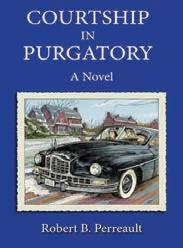

NOV. 18

NH Outright invites all ages to its community campus in Portsmouth from 6 to 8 p.m. to listen to an episode of “Out! And Into Open Arms,” followed by a discussion and Q&A. Dinner will be provided to attendees. nhoutright.org

NOV. 25
NOV. 19 AND DEC. 17
Positive Street Art invites creators of all ages to connect, create and share! Bring your own supplies to work on your craft, or simply enjoy networking with fellow local artists. Let’s inspire each other and grow our creative community. Come to Positive Street Art’s gallery, 48 Bridge St., #3F, Nashua, from 6 to 8 p.m. positivestreetart.org
Harbor Care, a nonprofit providing housing and services to veterans and families, will serve a free Thanksgiving Community Dinner for more than 300 vulnerable community members from 11:30 a.m. to 2 p.m. at Harbor Care Health & Wellness Center. The free meal is available to anyone in need of a hot meal and holiday cheer. harborcarenh.org

DEC. 7
Join Manchester True Collaborative once a month on a Sunday afternoon for a couple of hours to come and be social with like-minded people! Bring a snack or non-alcoholic drink to share. manchestertrue.org

DEC. 13
The rescheduled event will be a grand celebration combining the rich traditions of the 12th Annual Indonesian Festival with a joyous end-of-year and holiday celebration for the whole community! Enjoy incredible food, captivating cultural performances and vibrant arts you loved from past years, now with an added festive, holiday spirit. www.facebook.com/IndonesianConnect


DEC. 1 AND JAN. 5
Manchester True Collaborative hosts an open house on the first Monday of the month from 6:15 to 9 p.m. manchestertrue.org
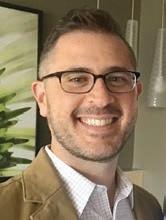

Empower Medical, based in New Hampshire, is Dr. Bobby Kelly’s virtual telemedicine company that enthusiastically welcomes new patients seeking compassionate care in a variety of areas, specializing in LGBTQ+ medicine and sexual health. Bobby Kelly, MD, MPH, FAAFP empowermedpllc@gmail.com www.empowermedi.com 978-242-7799
Sanborn Solutions is your go-to source for LGBTQ+ diversity and inclusion support. Through training and consulting, we can help your organization enhance its LGBTQ+ cultural competency and best practices.
Sanborn Diversity Training Solutions www.sanbornsolutionsllc.com 603-434-0068




Organizational Ignition helps organizations reach and sustain their ignition point through the integration and alignment of business processes, people and technology. Work with senior management to implement efforts that leverage strengths, eliminate weaknesses, capitalize on opportunities and minimize threats. Organizational Ignition, LLC www.organizationalignition.com 603-540-3988








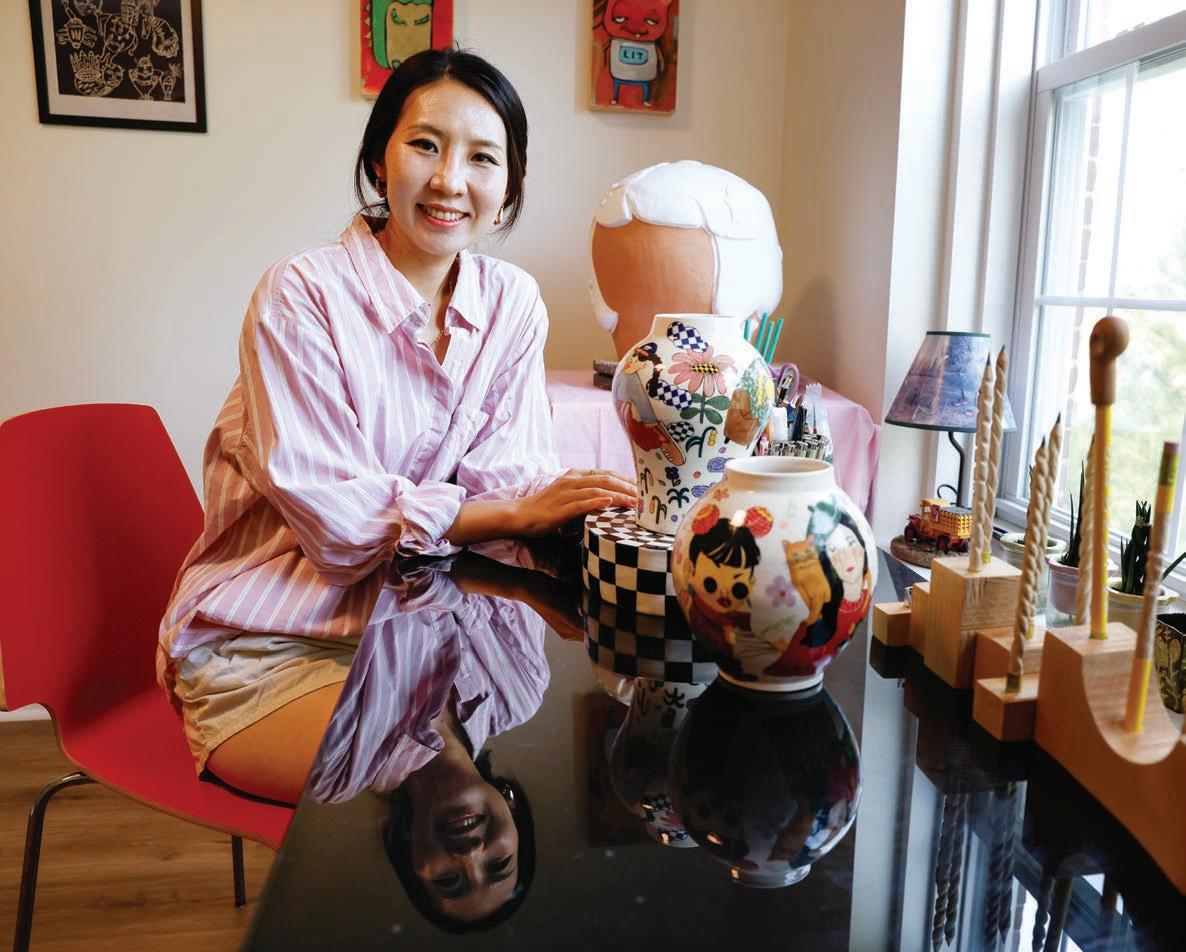
PHOTO BY CHERYL SENTER
Artist and art educator Jihye Han of Exeter bridges her life experiences in South Korea and the United States through pottery, paintings and larger works.
“In my work, I strive to bridge past and present, blending the traditions of Korea with the influences of America, just as I embody both cultures,” she said in a New Hampshire Charitable Foundation press release.
She recently received the 2025 Piscataqua Region Artist Advancement Grant from the New Hampshire Charitable Foundation to expand her work to larger pieces and to aid her students at Phillips Exeter Academy to explore their identity through art.
The $25,000 Piscataqua Artist Advancement grant is one of the largest unrestricted grants awarded to a single artist in the country.
The traditional Korean ceramic moon jar is central to Han’s work. Their simple round shape is inspired by the full moon, which symbolizes prosperity and good fortune. Adorned with Han’s expressive painting, each is a multicultural, thought-provoking personal story.
Traditionally, moon jars are made in two halves, with the top and bottom then joined to form a single, seamless whole. The process reflects her journey of living between two worlds.
“Like the two halves of a moon jar becoming one, I bring together my Korean and American identities to create a unified sense of home,” Han said.
Han is curating an online exhibit with Yeonsoo Kim, Didem Mert and Peter Jadoonath titled “DrawnTo” that opens Nov. 12 through Pots on Wheels. 603








